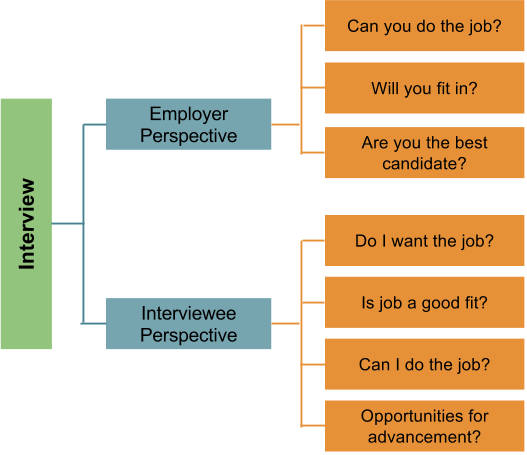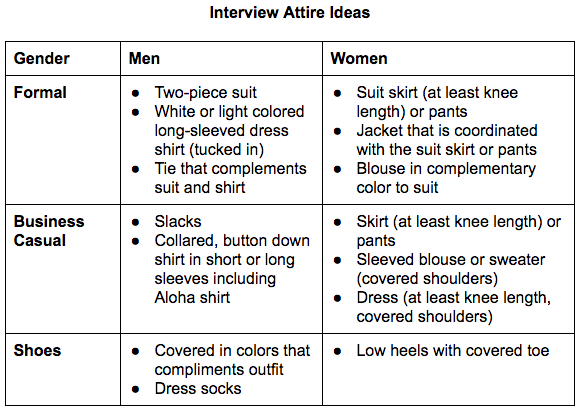Congratulations you have made it through the initial review of documents (i.e., resume, personal statement) and have been selected for an interview. This lesson will focus on making a great first impression!
Review the Required Resources thoroughly BEFORE going through the Graded Activities. Please be aware of the due dates associated with this lesson.
Required Resources
The Interview is Your Opportunity
(Estimated time to complete: 1 minute)
It is natural to be nervous for an interview. You will be in front of people you may or may not know answering a slew of questions. However, instead of thinking of the interview as this daunting task think of it as your opportunity to:
- Showcase your skills, abilities, and personality
- Express your genuineness and interest
- Provide examples of the relevancy of your studies and experiences
- See if the position, company, or program is a good fit for you
Keep in mind that the interview is not only about the program or company assessing you but you assessing them!

(Employer vs Interviewee Perspective on the Interview)
Interview Preparation: Do Your Homework
(Estimated time to complete: 12 minutes)
The first step in preparing for the interview is to do your homework. You need to ensure you have the key information. This includes the date, time, location, and parking situation. Other information you should know is the interview format (screening, one-on-one, panel, peer group, luncheon, skype), length of interview, and number of interviewers (and their names, if possible). You will also want to know if the program/positions requires multiple interviews.
You will want to also research the program or company you are interviewing. Use any literature you find on the program/company or do a search on their website to find out additional information. You can also talk to people who are knowledgeable about the program/company. Areas you will want to focus your research on include:
- Mission/Vision/Philosophy
- Primary services/functions
- Customers/Clients/Target Audience
- Position responsibilities
- Fit of the position in the company/program overall structure
- Names and job titles of key contacts in the company/program
- Size of the program/company (e.g., employees, students, faculty)
It is important that you are yourself during the interview. This means that you should have a clear idea of your career goals, life goals, accomplishments, skills, abilities, strengths, weaknesses, interests, and activities. To prepare yourself to talk about these things you will want to practice doing just that – talking about yourself. To do this, put together 2 – 3 sentences to introduce yourself. These sentences could cover your academic background, career interests, and goals. You should also practice responding to frequently asked interview questions including behavior-based questions. Interviewers will ask questions about past experiences as this is generally an indication of future performance. To respond to these type of questions follow the S.T.A.R. Approach:

(S.T.A.R. Approach to Answering Behavior-Based Questions)
During your preparation make sure to think of multiple examples. When determining which experiences to share you will want to prioritize sharing related work experience examples first. If relevant, student related experiences can be shared but should be secondary to work. Personally related experiences can shared as well but prioritize those last.
Students at the University of Hawai‘i at Mānoa can also take advantage of the Career Center and set up a mock interview with a career counselor.
You always want to ensure you arrive 10 – 15 minutes early for an interview. You never want to arrive late for an interview. Doing a test run beforehand, which means planning your travel according to the time of your interview, will eliminate the anxiety of trying to navigate to someplace new. Conducting a test run will give you a better estimate on how long travel will take. Make sure to turn off your cell phone when you arrive for an interview.
Also, you will want to go through all of your social media accounts (i.e., Facebook, Twitter, Instagram) to ensure you do not have an questionable content or photos. Interviewers will conduct an online search to assess whether you are an appropriate candidate.
For reinforcement of the content shared above watch Job Interview Tips – How to Prepare for a Job Interview (2:55 minutes).
Interview Attire
(Estimated time to complete: 18 minutes)
St. Bonaventure University has put together a slideshow on How to Dress for Professional Success to give you some general guidelines and definitions. However, interview attire should be based on the profession and company’s regional location. It is very important to gauge and determine the appropriate attire for the location as what is considered appropriate will vary by location and culture. Review the company website or visit the location prior to the interview get a sense of appropriate attire. For example, here in Hawai‘i Aloha shirts and dress slacks are appropriate for men to wear to an interview but this would not be the same in Chicago, IL.
Important aspects of your dress include looking your best, reflecting personal care, and projecting professionalism. You want employers to take you seriously. First impressions are lasting; you don’t have a chance to get that back so when thinking about how to dress for an interview think about how you want your first visual impression to be with the employer. Put yourself in the potential employer’s shoes… By taking the extra time to tailor your look contributes to a more positive first impression.
General guidelines for interview attire are provided below for your consideration. You can also view Dress for Success for suggestions. Remember this is subjective. You want to look professional and appropriate for the location/culture. When in doubt dress conservative.

Accessories Notes:
- All visible body piercing jewelry may need to be removed (pierced earrings ok for women but limit to one set)
- Depending on the situation dangling, large gaudy jewelry could be considered distracting or over the top
- Tattoos carry cultural significance in the Pacific so this is an area that is location and culturally specific and would need to be investigated prior
When you have identified your interview attire practice being in your outfit. Make sure it is comfortable and that the comfort will go the duration of the interview. For many of us we are not used to dressing in this manner so doing a “dress rehearsal” is important. The goal is to limit the number of new experiences at once and having you feel as comfortable as possible.
During the Interview
(Estimated time to complete: 3 minutes)
When introduced ensure that you follow the appropriate customs. This may mean a firm handshake or as is done often in Hawai‘i a cheek to cheek hello. You also want to ensure you smile and make good eye contact. Be aware of your non-verbal communication which includes your posture, eye contact facial expressions and gestures. Your image should portray that you want to be there.
An interview generally follows a simple structure:

(General Structure of the Interview)
When the interview starts listen carefully and allow yourself time to think before you answer a question. You can rephrase a question or ask the interviewer to restate the question, if appropriate. Keep your answers brief and concise (approximately 1 – 2 minutes) and make sure that you use specific examples, comparisons, and/or descriptions to support your answers. Maintain a conversation flow to your responses – you do not want to sound rehearsed. You want to come across as honest, positive, enthusiastic, and confident.
The body of the interview usually begins with an overview of the program/ company. Ensure that you listen carefully as this could be integrated into your responses. For any questions that are posed related to weaknesses respond by sharing a weakness that you have already identified a way to address. Be ready to respond to a question asking about your availability to start.
Any questions you have generally are asked towards the end of the interview. Make sure to ask the interviewer questions. You need to gather enough information to determine if that position/program is the right fit for you too. Examples of questions you may ask include:
- How would you describe a typical day on the job?
- What are some of the duties/responsibilities of this position?
- Who will be my direct supervisor?
- What are some recent changes of accomplishments that have occurred?
- What are the short and long-term strategic directions?
- What education or training programs does the company provide?
- How, when, and by whom will I be evaluated in this position? What are the performance criteria?
- When will you be making the hiring decision?
When developing your questions to ask interviewers you want to show that you are interested in the position. Ensure they are well thought out and cannot be found on the web site or in company literature. Do not ask about pay/salary and benefits as those are questions posed once an offer is received.
After the Interview
(Estimated time to complete: 1 minute)
Immediately after the interview take some time to write down your impression of the interview. You can jot down the questions that were asked, what you did well or what you may want to change next time. You will also want to promptly send a thank you (letter, email) to restate your interest, strengths and skills. Address your thank you specifically to those who participated in the interview with you. You should wait approximately 2 weeks to follow-up with an employer regarding the status of the position.
This lesson was adapted from the resources provided by the University of Hawai‘i at Mānoa Career Center.